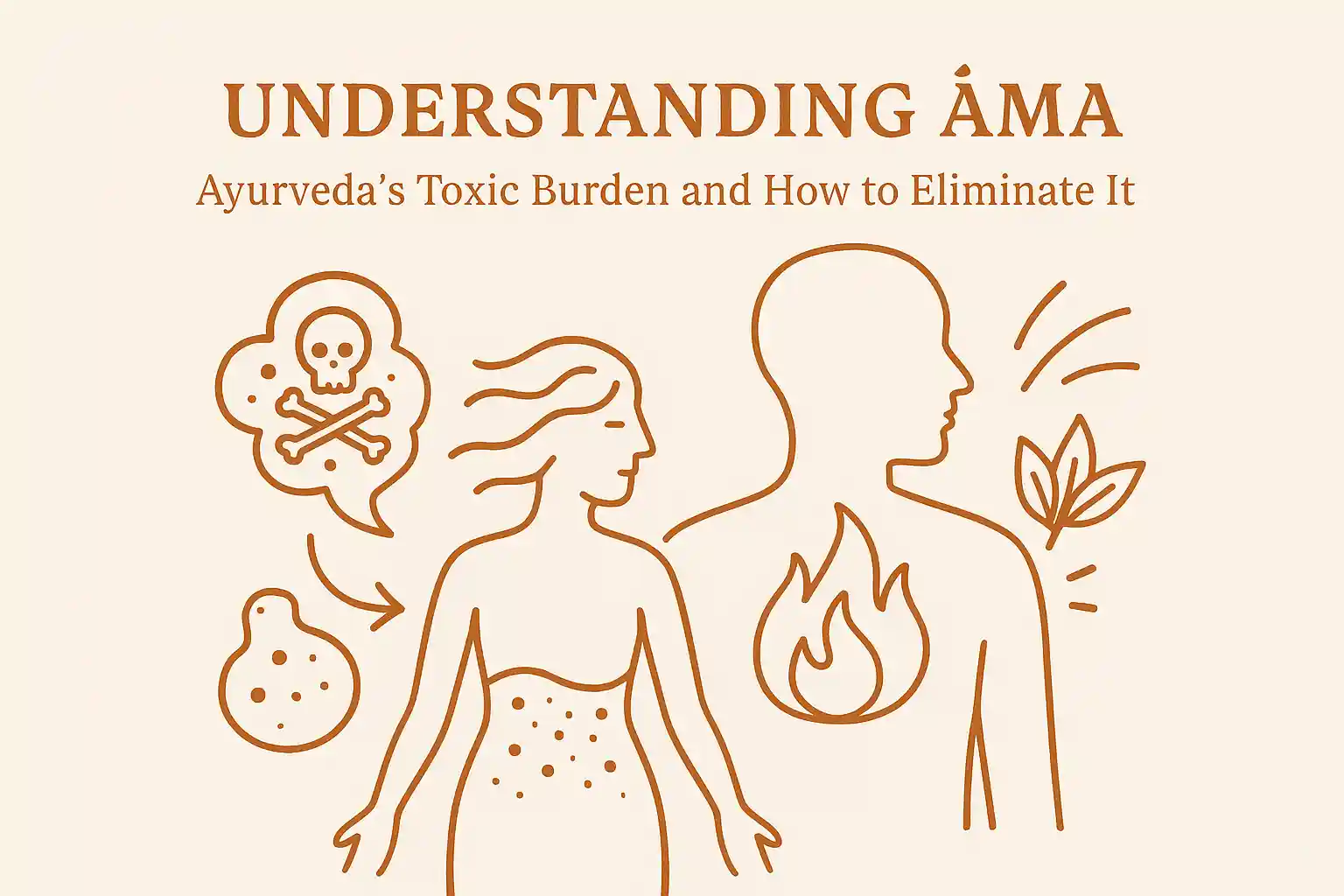Ama is one of the most fundamental and clinically important concepts in Ayurveda. Often described as the root cause of disease, Ama represents the accumulation of toxic, undigested residue in the body. To understand Ayurvedic detoxification, especially Panchakarma, it's essential to understand what Ama is, how it forms, and how it can be safely removed.
What Is Ama in Ayurveda?
In Sanskrit, "Ama" literally means "uncooked" or "undigested." In Ayurvedic physiology, it refers to the toxic byproduct of incomplete digestion—a sticky, heavy, foul-smelling substance that clogs the body's channels (srotas) and impairs normal physiological functioning.
Key Characteristics of Ama:
According to the Charaka Samhita, Ama is the initial stage of disease development. When Agni is weak, food is not properly metabolized, and the resulting Ama begins to accumulate in the digestive tract and eventually spreads to tissues.
"From the impairment of Agni arises Ama. From Ama, diseases develop."
How Ama Forms: Weak Agni and Poor Lifestyle
The root of Ama formation is impaired digestive fire or Mandagni. This can result from:
- Overeating or eating incompatible food combinations
- Consuming cold, heavy, processed, or stale foods
- Irregular meal times or emotional eating
- Chronic stress and unresolved emotions
- Sedentary lifestyle or suppression of natural urges
- Eating when not truly hungry
These habits compromise Agni, leading to partial digestion and the formation of Ama. Initially localized in the digestive tract, Ama can move deeper into the tissues if left unchecked.
Ama and Disease: The Ayurvedic View of Pathogenesis
Ama plays a central role in the Ayurvedic model of disease progression (Samprapti). It combines with the doshas (Vata, Pitta, Kapha), disrupts tissue metabolism (Dhatu Agni), and initiates pathological changes.
Vata-Ama
- • Joint pain and stiffness
- • Dryness and constipation
- • Anxiety and restlessness
- • Irregular digestion
Pitta-Ama
- • Inflammation and fever
- • Skin eruptions and rashes
- • Acidity and heartburn
- • Irritability and anger
Kapha-Ama
- • Congestion and mucus
- • Sluggishness and lethargy
- • Weight gain and swelling
- • Mental dullness
Over time, this toxic burden can contribute to more serious systemic diseases, including autoimmune conditions, metabolic syndrome, and chronic inflammatory disorders.
Ama in Modern Biomedical Terms
While Ama is a uniquely Ayurvedic concept, parallels can be drawn with modern science:
- Metabolic waste from incomplete digestion
- Endotoxins leaking into circulation due to poor gut barrier integrity
- Low-grade systemic inflammation from diet and lifestyle factors
- Oxidative stress and free radical accumulation
Modern research increasingly validates the link between impaired digestion, gut dysbiosis, and chronic inflammation—a resonance with Ayurveda's understanding of Ama.
How to Eliminate Ama Safely
The Ayurvedic approach to detox is not about aggressive purging, but systematic removal of Ama through rekindling Agni and supporting the body's natural elimination pathways.
Daily Detox Strategies
Simple Daily Practices:
- Warm, spiced meals - especially khichari for easy digestion
- Intermittent fasting - light eating or fasting one day per week
- Digestive teas - ginger tea or CCF (Cumin-Coriander-Fennel) tea
- Body therapies - dry brushing and abhyanga (oil massage)
- Gentle movement - yoga or walking to enhance circulation
Therapeutic Cleansing
For chronic or deep-seated Ama, classical detoxification is recommended:
Purvakarma
Prepares the body with oils and steam therapy
Panchakarma
Core five therapies for deep detoxification
Paschatkarma
Post-cleansing rejuvenation and Rasayana
Important: These therapies are highly individualized and should be done under the guidance of an experienced Ayurvedic practitioner.
Prevention: Strengthening Agni to Avoid Ama
The best way to prevent Ama is to keep Agni strong. Simple Ayurvedic habits can support this goal:
- Eat with mindfulness and regularity - consistent meal times support digestion
- Avoid overeating or eating when not hungry
- Favor seasonal, freshly prepared meals over processed foods
- Use digestive spices like ginger, cumin, black pepper
- Manage stress through pranayama, meditation, or adequate rest
Related Tools and Resources
Dosha Quiz
Understand your constitution and risk factors for AmaFood Checker
Identify foods that support or disturb your AgniMeal Planner
Build Ama-reducing meal plans personalized to your DoshaSymptom Checker
See if symptoms may relate to Ama accumulationFrequently Asked Questions About Ama
Conclusion
Ama is not just a concept—it's a framework for understanding how imbalance and toxicity arise from daily choices. By recognizing the signs of Ama and taking proactive steps to strengthen Agni, you can prevent disease at its root and build strong Ojas (vital essence) for lasting health. For deeper detoxification, Panchakarma offers a time-tested path to clear Ama and restore systemic balance.
Remember, the journey toward eliminating Ama is gradual and gentle. Start with simple daily practices to strengthen your digestive fire, and consider deeper cleansing methods only under proper guidance. Unlike healthy waste products (Mala) that the body naturally eliminates, Ama requires conscious effort to clear. Your body has an innate wisdom to heal—Ayurveda simply provides the roadmap.
Related Articles

Ayurvedic Diet to Reduce Bloating: Natural Solutions for Digestive Comfort
Discover how Ayurvedic principles can naturally reduce bloating through Vata-pacifying foods, digestive spices, and lifestyle practices that strengthen Agni and eliminate gas.
8 min read
What Is Agni? A Beginner's Guide to Ayurvedic Digestive Fire
Discover Agni, the vital digestive fire in Ayurveda that transforms food into energy and health. Learn the 4 types of Agni, signs of imbalance, and practical ways to strengthen your digestive fire naturally.
12 min read
